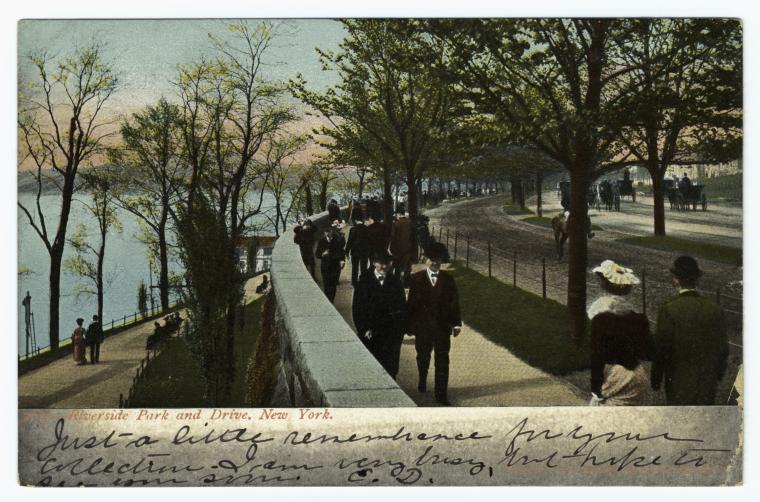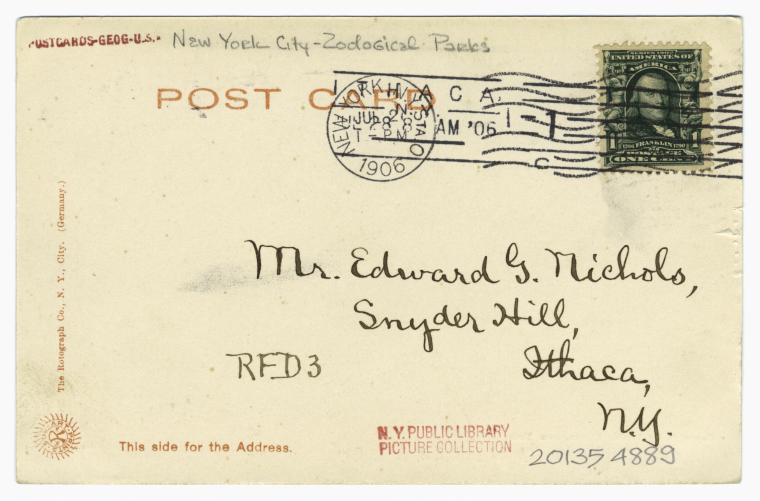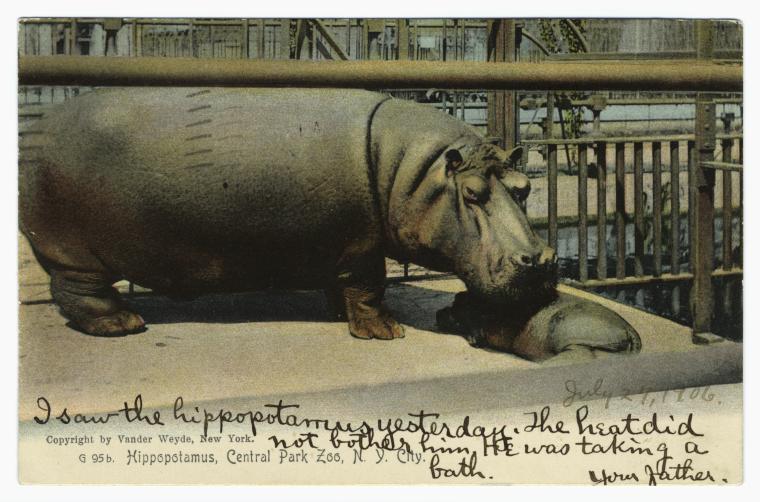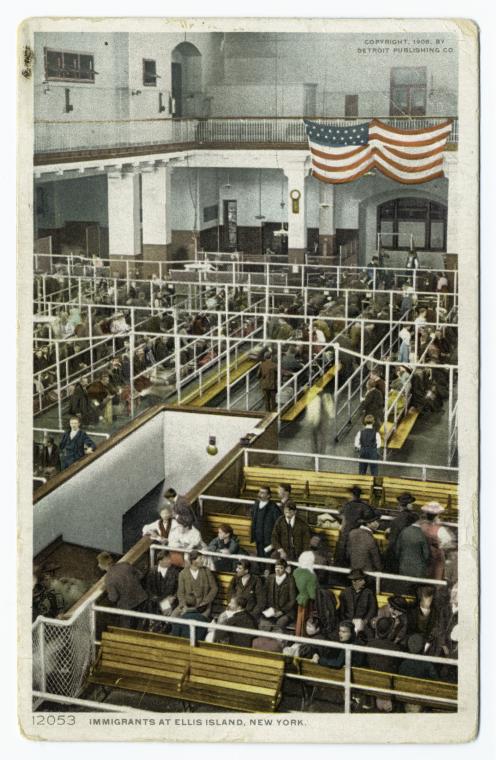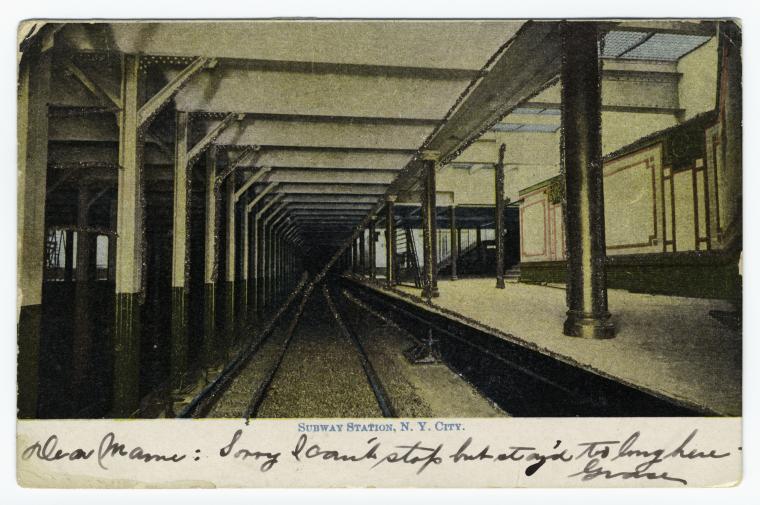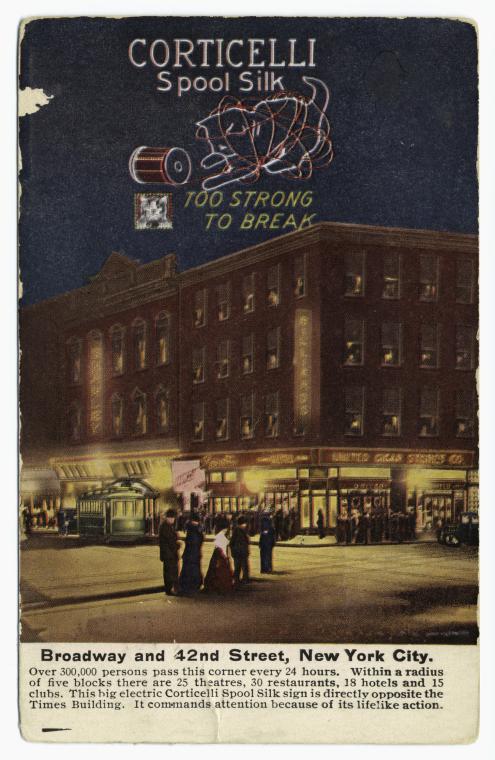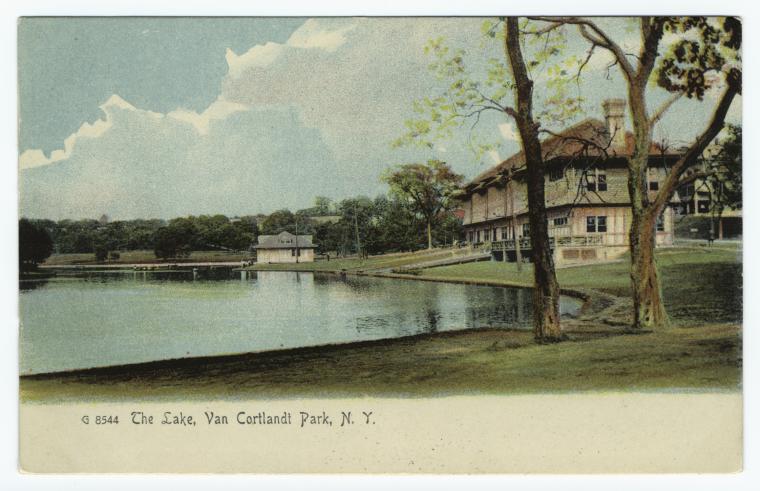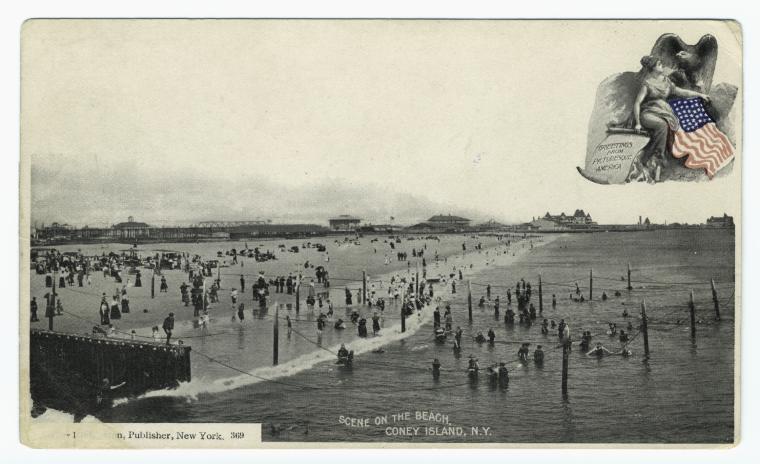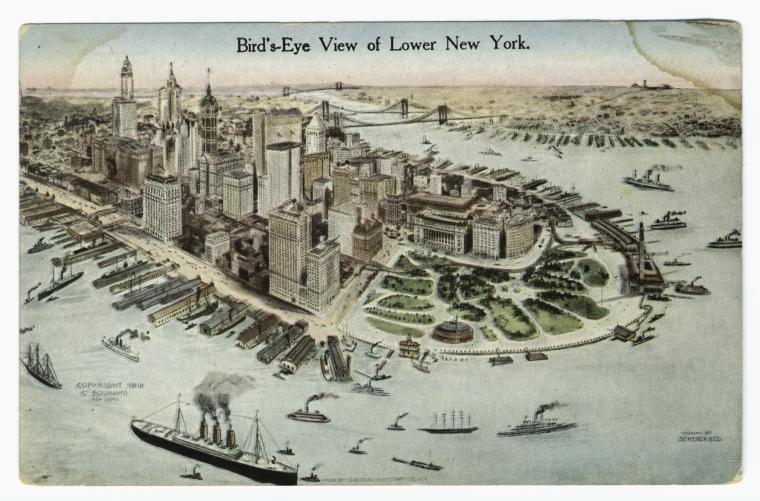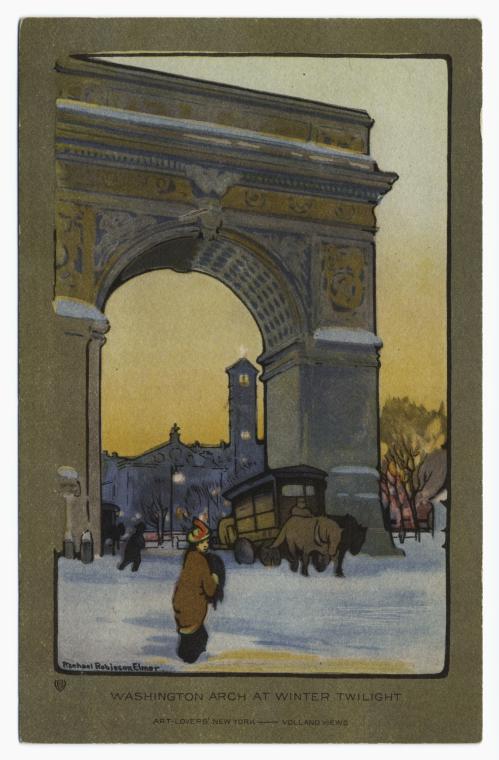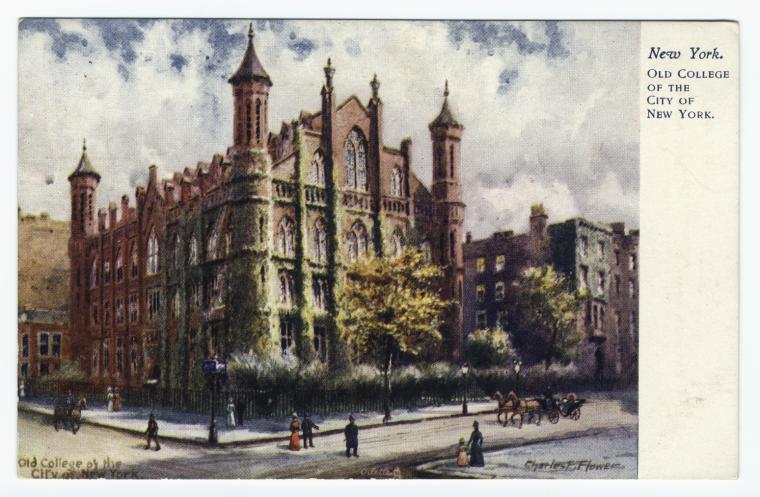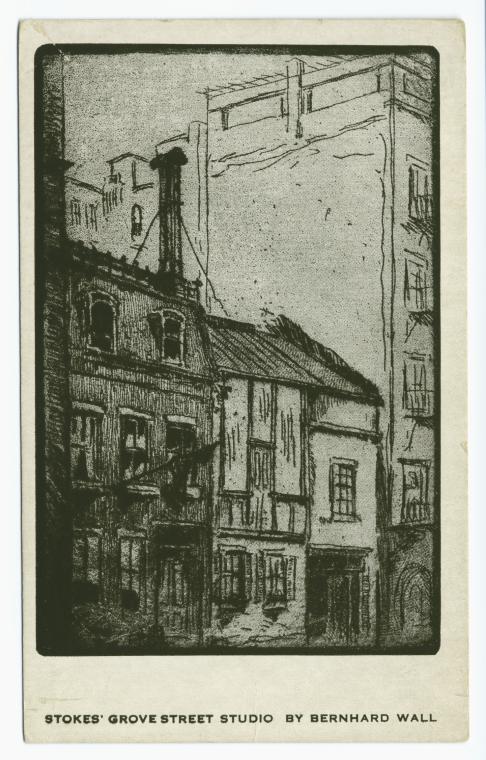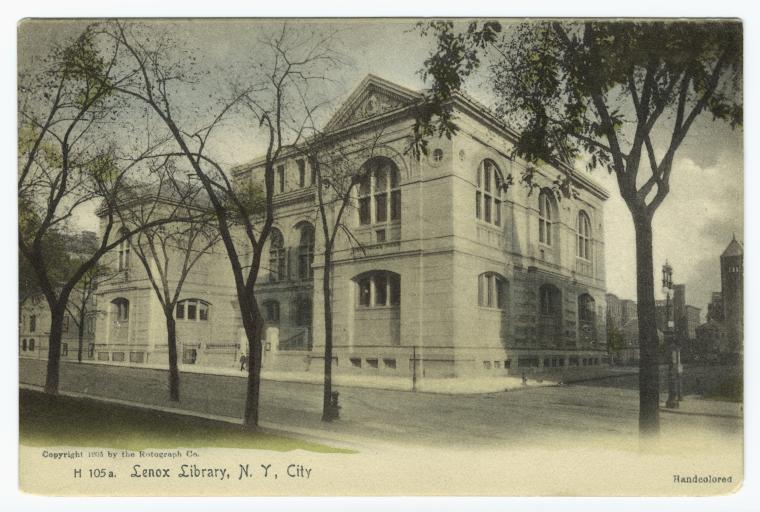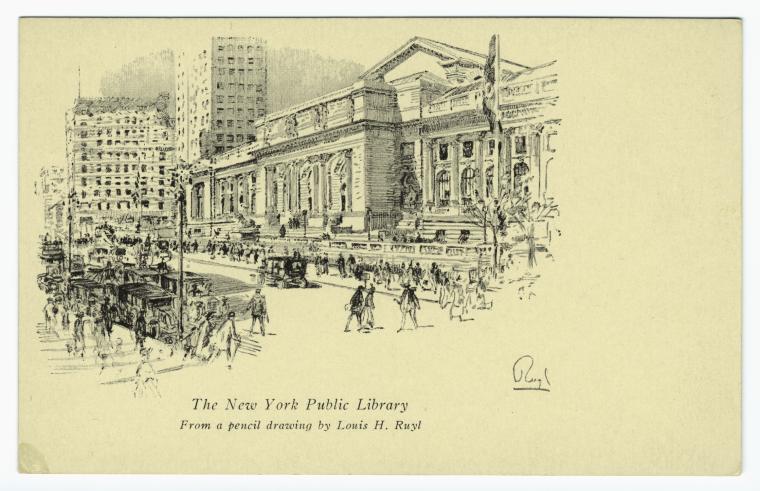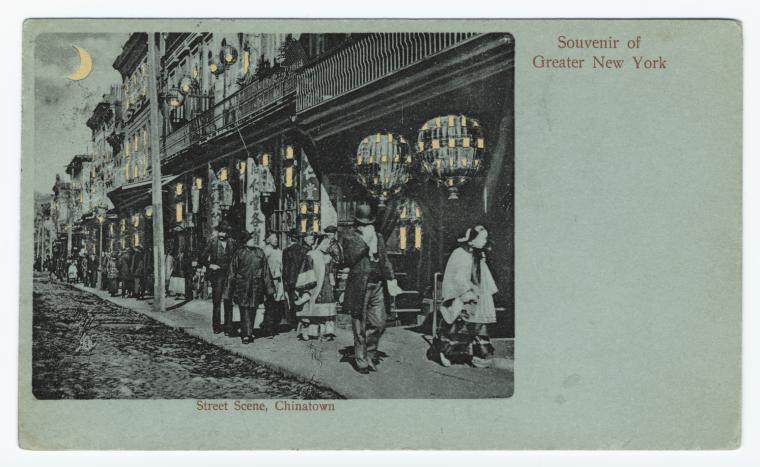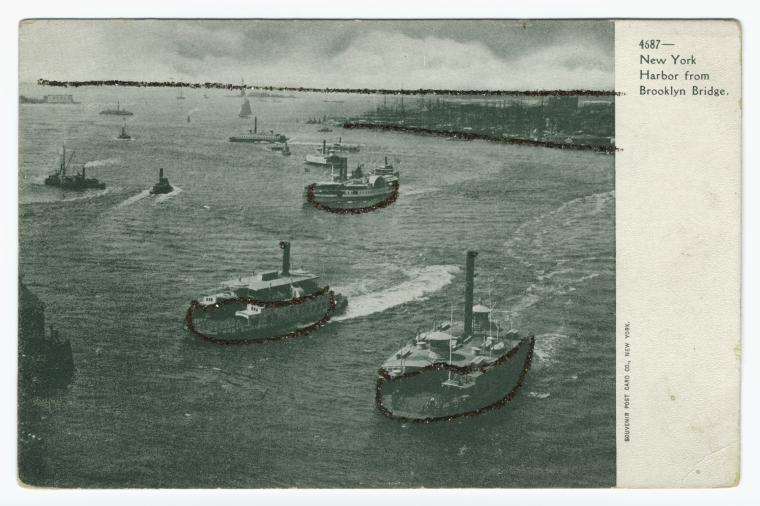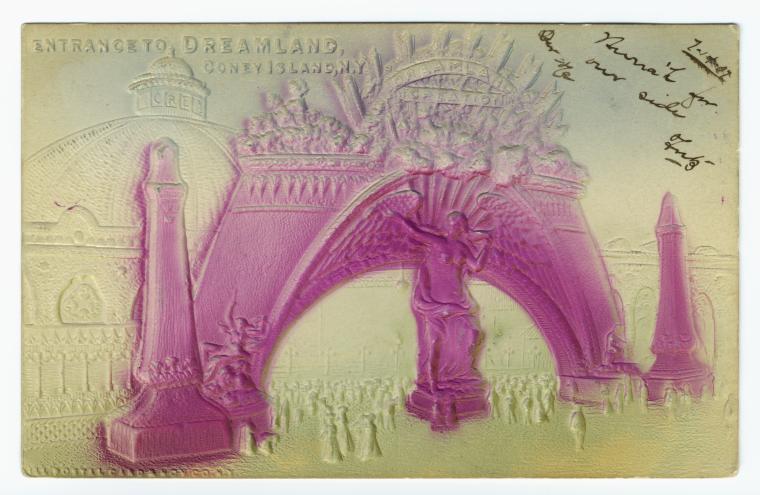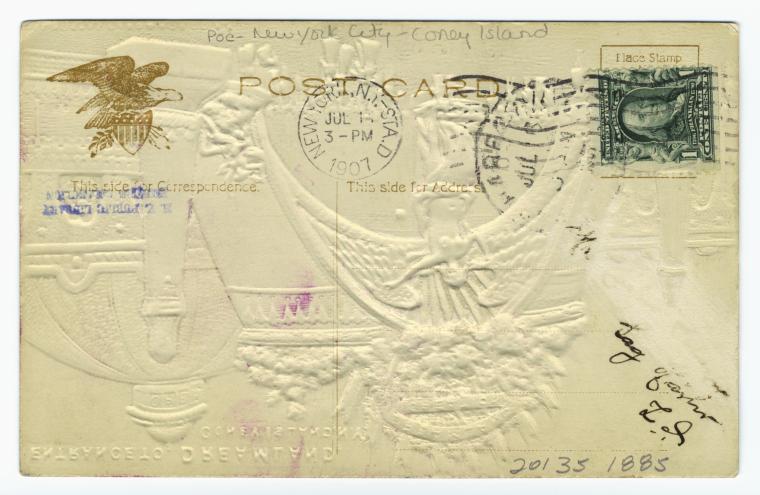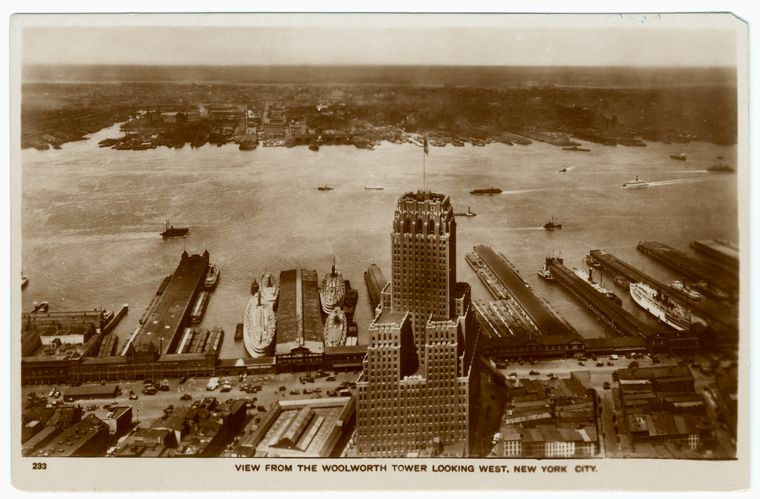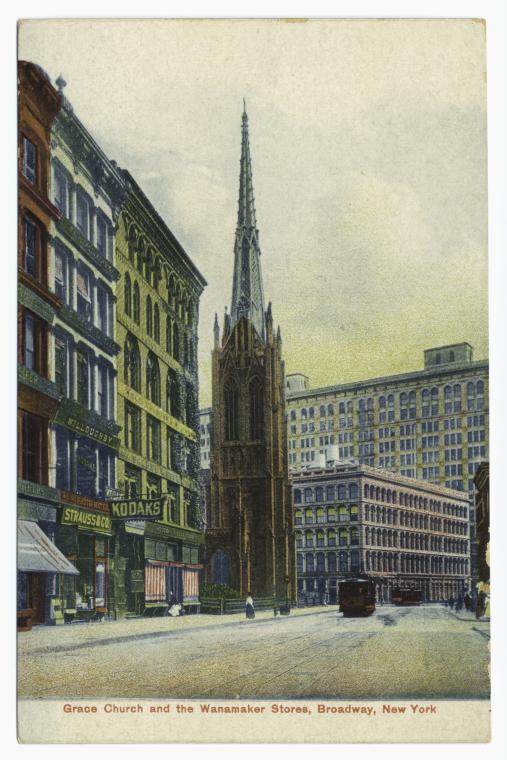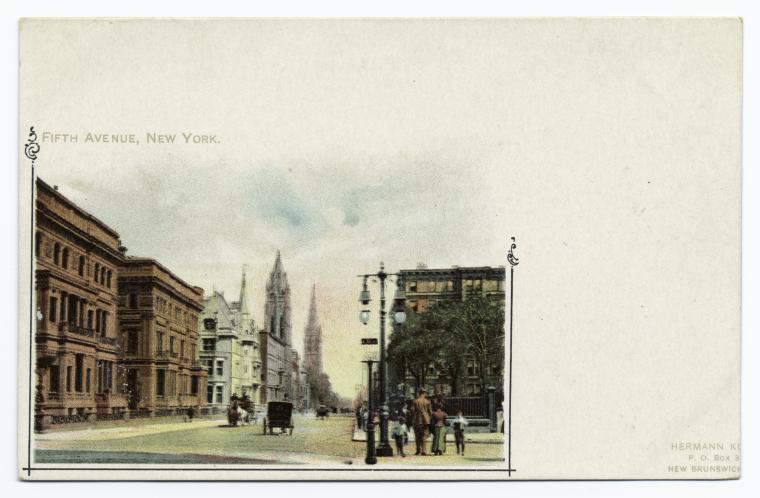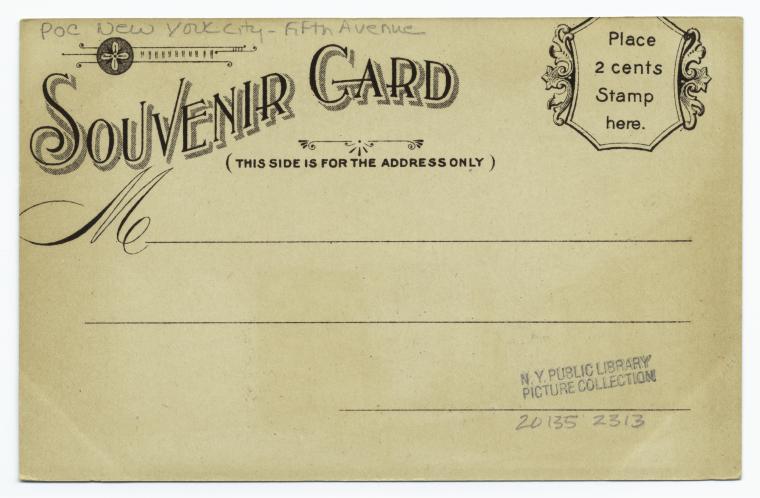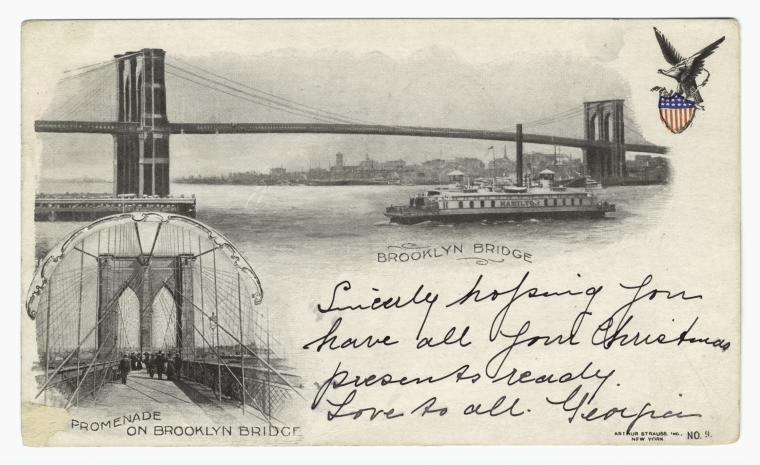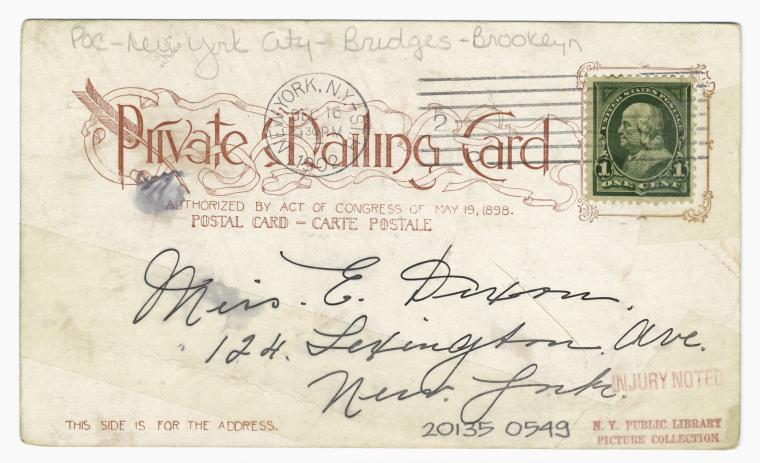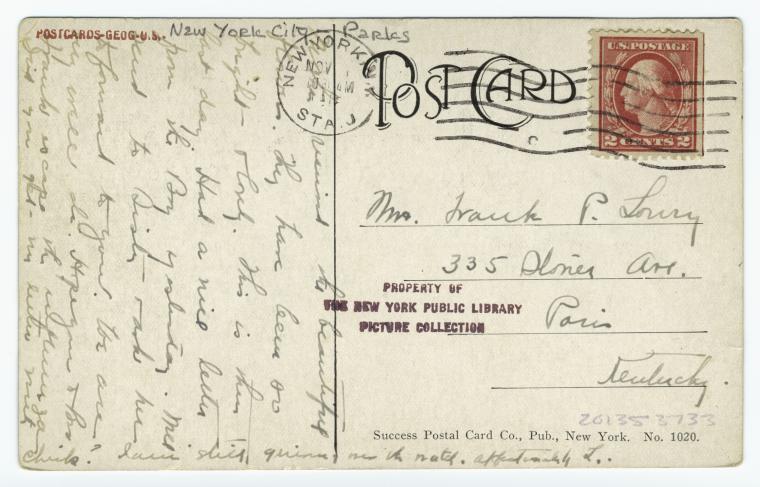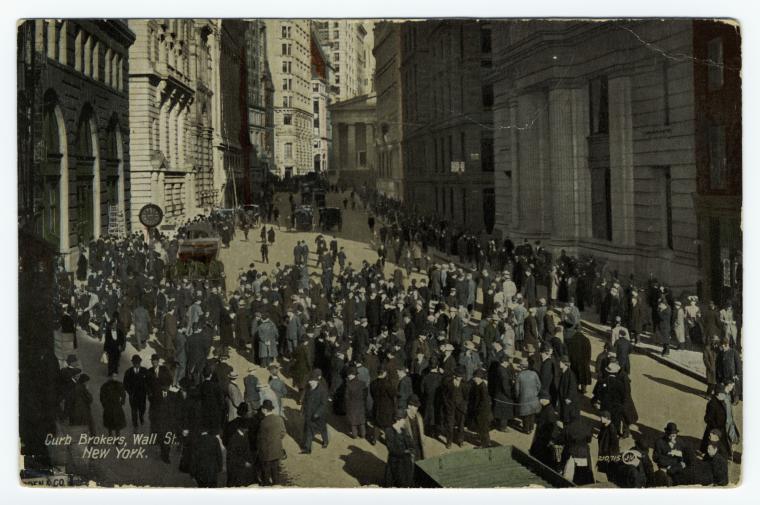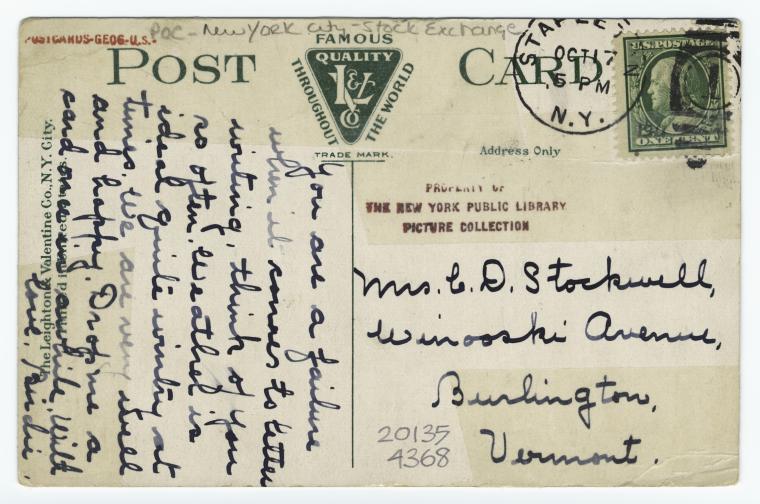Historical Postcards of New York City from the Picture Collection
Dear Reader,
“Just a little remembrance for your collection. I am very busy, but hope to see you soon. E.D.” November 10, 1905.
500 postcards depicting views of all five New York City boroughs in the late 19th and early 20th century from the Picture Collection's holdings of more than 25,000 postcards are available in the NYPL Digital Collections. The postcards provide a colorful visual record of the city and document the beginnings of the postcard publishing phenomenon in the United States.
The end of the 19th century was the beginning of the golden age of postcards. Advances in printing and photography allowed the mass production of captivating visual images affordable and available to everyone. Swept up in a fad that hasn’t yet lost its appeal, millions of people at once began collecting and sending a visual record of their travels and tastes. The postcards also illustrate emerging lithographic and photographic printing styles. Among the examples in this digitized collection are oil paintings, tinted photographs, colored lithographs, line photoengravings, relief prints, inkless intaglio prints, linocuts, hold-to-light cards, and cards with highlights delineated by glitter.
Both the front and the back of the postcards have been digitized. This added feature opens windows on typographic style, on the content and creator of the card, and on the perspective of the individual long ago penning greetings to a friend, a family member or a fellow worker. Here, a father instructs his child about the habits of a New York City hippopotamus.
A Record of Time
The dawning of the 20th century, coinciding with the peak of the industrial age, saw the foundation poured for many characteristics of New York living known worldwide.
The City is home to a diverse population, representing every language and nationality. The main Ellis Island immigration center opened on Dec. 17, 1900 and was designed to process 5,000 immigrants a day. This postcard was published one year after Ellis Island’s peak year—1907—when 1,004,756 immigrants passed through the facility. Here, they can be seen patiently waiting to be afforded entry onto Manhattan’s shores.
The City is renowned for public transportation. When the first subway opened on October 27, 1904, 150,000 people paid a nickel each to ride. This postcard, which uses applied glitter to highlight the shiny metal of the rails and beams, was postmarked two years after that opening. The writer of the card expresses a lament often heard from New York commuters: "Dear Mame: Sorry I can’t stop but stay'd too long here. Grace." Also digitized are many examples of street railroads and elevated railroads.
New York is the town for showmanship and advertising. The postcard to the right, advertising Corticelli Spool Silk, also depicts some of the first exuberant animated electric signage to play in Times Square. The sign is described on the postcard as 45 feet wide by 50 feet high; the kitten as 36 feet wide by 30 feet high; and the lighting achieved by the use of 1,962 electric lamps.
In August of 1909, Miss Jessie Stockwell of Burlington, Vermont received a card showing leafy green Union Square with the message, “Furs are being worn here in the city. Sorry I left mine at home. Nothing like being in style. Helen”
It is hard to imagine needing a fur in August. The New York Times from August 11, 1909 has the weather as "fair, moderate temperature to-day". It sounds like it was a lovely summer to be in New York.
A Record of Place: all five boroughs
Scenes from all five boroughs of New York have been selected to tantalize the viewer into venturing to the Picture Collection to scour through thousands of images depicting New York neighborhoods from the arrival of the Dutch in New York harbor to the opening of the Bronx Library Center in 2006. A dip into these images offers a refreshing look at a city surrounded by water.
Bronx
Brooklyn
Manhattan
Queens
Staten Island
A Record of Art
Early postcards were typically printed in Germany, where the art of lithography had reached a level of refinement and cost-effectiveness not found elsewhere. The high quality of printing enticed the public to collect the cards, and assured artists that their work would be reliably and attractively reproduced. Art reproductions were finally within the reach of the populace, who avidly filled albums with their favorite images. Postcard publishers commissioned battalions of artists to fill the demand.
Rachael Robinson Elmer, gained fame for two sets of fine art postcards depicting New York. Washington Arch at Winter Twilight is from the first set, published in 1914 by P.F. Volland Company. Two years later, she issued the second set on her own, publicizing the event with a poster. Views of Grant’s Tomb and the Woolworth Building on a June night are examples of the second set.
The firm of Raphael Tuck, the most prolific British publisher of postcards, commissioned several series of New York views from painters working in oil. These postcards were dubbed “Oilettes.” This painting of the Old College of the City of New York (the first home of CCNY) was done by Charles F. Flower, one of the foremost of Tuck’s artists.
Bernhard Wall designed over 5000 comic postcards, earning the title of “Postcard King.” After 1915, he devoted himself more seriously to etching. This rendering of the Greenwich Village studio of the painter and welfare worker Helen Olivia Phelps Stokes is an example of his later work.
The artist of this 1908 lithograph of the waiting room for women in the now demolished Penn Station, identified in the caption as S. Goodman, may have self-published the card. Anyone could be a postcard publisher, and many artists, both prominent and obscure, took advantage of this small medium to showcase their talents. Particularly noteworthy is the patterning of the dresses on the women who wait.
The historical postcards also document the art of architecture with a rich supply of images of buildings still thriving and long since demolished. The Lenox Library, a Greek Revival Building on Fifth Avenue and East 71st Street designed by Richard Morris Hunt, was demolished in 1913 to make way for the mansion that now houses the Frick Collection. Two years earlier, The New York Public Library moved the collections of the Lenox Library to join the Astor Library and Tilden Foundation collections in a splendid new structure built by Carrere and Hastings on the corner of 42nd and Fifth.
A Record of Style
Two pathways to style can be traced through the Historical Postcards of New York City. The images on the front of the cards display an amazing variety of techniques available to the postcard maker in depicting a view. The backs of the cards illustrate typographic styles popular at the turn of the century, as well as legal requirements that help to date the cards.
The image side: technical virtuosity.
Postcard creators and publishers made profitable use of new printmaking methods in lithography, photography, etching and screenprinting, often adding a few creative flourishes of their own.
Hold to light cards
This depiction of a Street Scene in Chinatown at night is a “Hold to Light” card. Holding these two-layered cards to a light source accentuates the light from the moon, lanterns and windows depicted.
Tinsel and glitter
Silver and gold glitter was applied to emphasize contours of buildings or to outline forms. In this image of New York Harbor from the Brooklyn Bridge, red and silver glitter glides the eye to the boats, the shoreline, and the horizon.
Embossing
Elaborate embossing on cards depicting Coney Island and other places for lighthearted pursuits made them perfect souvenirs. Owners of these cards could also reproduce the image by rubbing a pencil across a piece of paper placed over the card.
Real photographs
The rising popularity of photography ensured its prominence as a postcard medium, as negatives could easily be developed on photopaper with pre-printed text on the back. Publishers distinguished “real photographs” from other printing techniques with an announcement on the card. This View from the Woolworth Tower looking West is identified as “a genuine photograph“on the reverse.
Lithographic Techniques
Technical advances in lithography permitted large print runs of postcards using different hand-colored plates for each color. Imaginative applications of ink sometimes give the New York streets a fairytale flavor.
Stencil and brush (pochoir print)
The stencil and brush methods used in this evocative rendition of a New York City sunset were precursors to screenprinting techniques developed and adapted by the pop art movement half a century later.
The address side: a chronology of style
For tourists, immigrants, residents and relatives, a souvenir of the sights of the Big City proved irresistible, and postcard publishers responded with an inexhaustible supply of sets picturing New York. The Historical Postcards of the Picture Collection show every stage of the “golden age” of picture postcards.
Postcards published from 1893 (when the first set of picture postcards in the United States was issued) through 1898 are termed “pioneer”. Because the Post Office reserved the term “postcard” for blank cards with postage affixed, these cards are imprinted with other descriptive words, such as “Souvenir.” They also cost 2¢ to mail.
In 1898, the U.S. government extended to private publishers the same 1¢ postage rate in effect for the blank government cards, but required special wording on the address side of the card advertising their generosity. Postcard makers embellished the prescribed language with elaborate typographies.
On December 24, 1901, the language requirements were eased—the term “Post Card” was permitted. Flamboyant typographies showed no sign of diminishing.
In the early years, the postcard correspondent was strictly forbidden to write anything other than the address on the back of the card. As the aesthetic quality of the pictures on the front of the card advanced, fitting more than a signature became problematic. This view of a violet sunset at sea allows only a small scroll at the bottom left for the message.
On March 2, 1907, the space on the back of the card was divided to allow for messages and the format of the postcard as we know it today came into being.
A Record of the People
For visitor and native alike, New York’s unstoppable energy radiates from its people. Their postures and clothes capture a taste of the time that can feed the imaginations of novelists, historians, costume designers, filmmakers, and family chroniclers trailing the stories of their forefathers and foremothers.
How to find the postcards
To see all the Historical Postcards of New York City from the Picture Collection in no particular order: https://digitalcollections.nypl.org/collections/historical-postcards-of-new-york-city#/?tab=navigation
For more about the history and use of postcards visit Carmen Nigro’s fantastic blog post: Using Postcards for Local History Research, or try some of these books:
Books
Carline, Richard. Pictures in the post: the story of the picture postcard. Bedford, England: G. Fraser [1959].
Klamkin, Marian. Picture Postcards. New York: Dodd, Mead & Co., 1974.
Miller, George and Dorothy. Picture Postcards in the United States 1893-1918. New York: Clarkson N. Potter, Inc., 1976.
Phillips, Tom. The Postcard Century: 2000 cards and their messages. New York: Thames & Hudson, 2000.
Sincerely
In October 1917, a girl named Birdie wrote to Mrs. I.D. Stockwell. We can imagine they were sisters, one living in New York City, the other in Burlington, Vermont. And, we can only wonder why Birdie chose a postcard depicting “Curb Brokers” on Wall Street to send her greetings. But, she writes what we’re all thinking sometimes:
“You are a failure when it comes to letter writing. Think of you so often. Weather is ideal quite wintry at times. We are very well and happy. Drop me a card once in awhile. With love, Birdie”
Or, perhaps, B.L.D. wrote it best,
“Dear Wallace I will be over if it don’t rain Saturday.”
Sincerely,
Jessica
This post is an edited version originally published as a project called Digitizing Historical Postcards of New York City from the Picture Collection’s Reference File. It was supported in part by funds from the Metropolitan New York Library Council (METRO) through the New York State Regional Bibliographic Databases Program. Curatorial content was originally gathered and written by Susan Chute for The New York Public Library. Thank you to Raymond Khan and Zoe Waldron for their help with this project!
Read E-Books with SimplyE
 With your library card, it's easier than ever to choose from more than 300,000 e-books on SimplyE, The New York Public Library's free e-reader app. Gain access to digital resources for all ages, including e-books, audiobooks, databases, and more.
With your library card, it's easier than ever to choose from more than 300,000 e-books on SimplyE, The New York Public Library's free e-reader app. Gain access to digital resources for all ages, including e-books, audiobooks, databases, and more.
If you don’t have an NYPL library card, New York State residents can apply for a digital card online or through SimplyE (available on the App Store or Google Play).
Need more help? Read our guide to using SimplyE.
